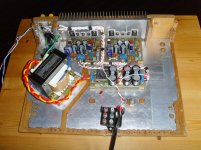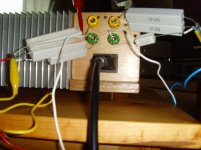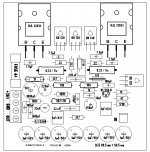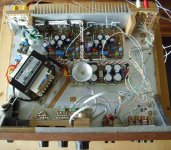Hi AJT,
After one hour I could touch it continuously but after around two hours was able to touch it for maybe 10 sec or more. The AC voltage dropped from 31.5V unloaded to around 29V under 80W of load.
DC voltage was 41.5V unloaded and 34V loaded. Please note that there is a .5 ohm series resistor between the capacitor banks of the power supply, which causes the DC to drop additionally under load.
I think I need to make a sine wave test at some point, just to see how hot the whole thing gets.
You are right when you say that normal listening doesn't break an amp, even the worst party loading seldom does! And if it does, it mostly the output transistors that smoke and rarely the transformer....
After one hour I could touch it continuously but after around two hours was able to touch it for maybe 10 sec or more. The AC voltage dropped from 31.5V unloaded to around 29V under 80W of load.
DC voltage was 41.5V unloaded and 34V loaded. Please note that there is a .5 ohm series resistor between the capacitor banks of the power supply, which causes the DC to drop additionally under load.
I think I need to make a sine wave test at some point, just to see how hot the whole thing gets.
You are right when you say that normal listening doesn't break an amp, even the worst party loading seldom does! And if it does, it mostly the output transistors that smoke and rarely the transformer....
It's Alive!
Yes, now we have finally reached the testing phase even if there is a lot of work still to be done. I fired it up and connected a pair of very old cheap speakers. A Marantz CD7300 delivers the music through a 50k volume pot.
I seem to work smoothly and no smoke has appeared so far. There is a small thump at power on, otherwise it is very quiet with no signal. No hum or hiss, much better than expected for a first build.
It sounds much clearer than the 30 years old Sony, voices are great but there is something missing in the lower end, making the music sound a bit thin and without "punch". I wonder what causes this issue, but it may be speaker related.
It may need some tone control or just a bass-lift knob that can be pushed when needed, please suggest a solution?
More testing to be done, I will keep you updated.
Yes, now we have finally reached the testing phase even if there is a lot of work still to be done. I fired it up and connected a pair of very old cheap speakers. A Marantz CD7300 delivers the music through a 50k volume pot.
I seem to work smoothly and no smoke has appeared so far. There is a small thump at power on, otherwise it is very quiet with no signal. No hum or hiss, much better than expected for a first build.
It sounds much clearer than the 30 years old Sony, voices are great but there is something missing in the lower end, making the music sound a bit thin and without "punch". I wonder what causes this issue, but it may be speaker related.
It may need some tone control or just a bass-lift knob that can be pushed when needed, please suggest a solution?
More testing to be done, I will keep you updated.
Testing still ongoing
Thank you Carlos, your design seems to work well so far.
During the last week I did some load testing using a resistive divider consisting of two 15 ohm resistors in parallell and then in series with a 0.5 ohm resistor to ground. The speakers were connected across the 0.5 ohm resistors giving a reduction of the output voltage of 8 times or 24dB. Then I could drive the amp into clipping at a comfortable listening level. By using an old analog multimeter I found that clipping started around 8 volts, while the power supply dropped from 39 to 36 volts during this exercise. The 15ohm/20w load resistors got quite hot, but the heatsink stayed relatively cool.
More to come, stay tuned....
nnx
Thank you Carlos, your design seems to work well so far.
During the last week I did some load testing using a resistive divider consisting of two 15 ohm resistors in parallell and then in series with a 0.5 ohm resistor to ground. The speakers were connected across the 0.5 ohm resistors giving a reduction of the output voltage of 8 times or 24dB. Then I could drive the amp into clipping at a comfortable listening level. By using an old analog multimeter I found that clipping started around 8 volts, while the power supply dropped from 39 to 36 volts during this exercise. The 15ohm/20w load resistors got quite hot, but the heatsink stayed relatively cool.
More to come, stay tuned....
nnx
Attachments
This one is old style..but updated.... some decisions and tricks applied
are modern...it uses capacitor in series in the output...do not think this harms the sound before you listen this one.
A low power unit that sound very pleasant.
regards,
Carlos
are modern...it uses capacitor in series in the output...do not think this harms the sound before you listen this one.
A low power unit that sound very pleasant.
regards,
Carlos
So far so good....
My DX-Trust has been playing happily in prototype mode for more than a month now. Finally I got the front panel with the controls in it attached and I am now testing the inputs, volume and balance controls. Only the CD (direct) input is working now, it seems like the the loss in the volume-balance pots is larger than expected, and the CD-player has some difficulties driving the amp to full volume.
But that will not a problem since a preamp (DOZ) is already planned. It will be useful for low input sources like tape recorders and tuners. A phono stage is also on the drawing board as well as a single knob tone tilt control. Also a loudness knob is included, but I am not satisfied with the performance and need to change the component values.
When listening carefully there is a faint hum audible in the woofers. When shorting the input connectors on the amp modules the hum goes away, so it must be injected through the input wires somehow. And when I switch the power off the hum disappears straight away even if the amp is still under power for ½-1 minute due to the large power supply capacitors. So I guess that the hum comes from the transformer or power supply itself.
I use twisted pairs (from ethernet cable) as signal wires, with the ground connected only at the one end, but maybe I should try to switch to properly shielded signal cables? Or it may be one of those dreaded ground loops again....? Anyway, it is not a big problem, and I believe it will be sorted out somehow.
My DX-Trust has been playing happily in prototype mode for more than a month now. Finally I got the front panel with the controls in it attached and I am now testing the inputs, volume and balance controls. Only the CD (direct) input is working now, it seems like the the loss in the volume-balance pots is larger than expected, and the CD-player has some difficulties driving the amp to full volume.
But that will not a problem since a preamp (DOZ) is already planned. It will be useful for low input sources like tape recorders and tuners. A phono stage is also on the drawing board as well as a single knob tone tilt control. Also a loudness knob is included, but I am not satisfied with the performance and need to change the component values.
When listening carefully there is a faint hum audible in the woofers. When shorting the input connectors on the amp modules the hum goes away, so it must be injected through the input wires somehow. And when I switch the power off the hum disappears straight away even if the amp is still under power for ½-1 minute due to the large power supply capacitors. So I guess that the hum comes from the transformer or power supply itself.
I use twisted pairs (from ethernet cable) as signal wires, with the ground connected only at the one end, but maybe I should try to switch to properly shielded signal cables? Or it may be one of those dreaded ground loops again....? Anyway, it is not a big problem, and I believe it will be sorted out somehow.
Attachments
Your transformer is too much close, to much nearby the power amplifier input
Then you may have 60 hertz (your mains frequency) induced to the power amplifier input...clearance there is minimum of 5 inches.
As you have not room do that ...then install a stand by blade of metal (must be iron) in between the transformer and the power amplifier input...as a shield, alike a wall to separate power amplifier input and transformer.
Or transformer can be inside a case, covered by a metalic case alike a PC supply case...the metal must be grounded.
Increasing the sensitivity to allow your signal to drive the amplifier, will produce, as a result lots of induced hum...it is not a good idea to increase without fix, in advance, the issue of the nearby transformer.
Thank you by your picture...please inform your country to my registrations.... i know some Greeks, Croatians and Italians have assembled....i am interested to know more about builders of this vintage style amplifier
regards,
Carlos
Then you may have 60 hertz (your mains frequency) induced to the power amplifier input...clearance there is minimum of 5 inches.
As you have not room do that ...then install a stand by blade of metal (must be iron) in between the transformer and the power amplifier input...as a shield, alike a wall to separate power amplifier input and transformer.
Or transformer can be inside a case, covered by a metalic case alike a PC supply case...the metal must be grounded.
Increasing the sensitivity to allow your signal to drive the amplifier, will produce, as a result lots of induced hum...it is not a good idea to increase without fix, in advance, the issue of the nearby transformer.
Thank you by your picture...please inform your country to my registrations.... i know some Greeks, Croatians and Italians have assembled....i am interested to know more about builders of this vintage style amplifier
regards,
Carlos
Attachments
Nnx,
lot's of evidence of twisted pairs, well done.
These are good enough to cancel the fields from mains cables and/or transformers.
Your hum problem is almost certainly due to a ground loop, when you connect the other equipment.
lot's of evidence of twisted pairs, well done.
These are good enough to cancel the fields from mains cables and/or transformers.
Your hum problem is almost certainly due to a ground loop, when you connect the other equipment.
For audio input you should use coaxial audio cables
Try to avoid AC nearby audio cables..they cannot run in parallel
Twisted cables are not good enough to be rid of interference... replace all
audio input cables with audio coaxial cables.
Please Andrew, your interference, this time, was a tragedy...do not do that in special when the guy is facing troubles exactly because of twisted pairs.....i could not see the cables as non coaxial cables...i could see that now.. the non coaxial cables being used escaped from my perception first sight.. then i was thinking about nearby transformers but this practice, the twisted pairs, is even worse.
I know you do not appreciate uncle charlie...we match and even about that..but do not do such kind of thing because you are damaging the builder hopes.....i am sure you know the basic things about shielding...so... i cannot understand your interference is impressive, also there's an impression of evil thing....there are two options... lack of competence or badness.... i cannot believe you are inserted in the first.. also cannot believe you are that bad.
Thanks lord i could see that, as i do not use to return to threads already answered or commented before next posting...i do not use to be tracking threads so often... an awful game would start....alike the dog catching it's own tail..the guy would follow my instructions about transformer shield and will continue to capture mains from the air, from home mains wiring as he is using twisted pairs, something i could not see first time..... we cannot be playing with our community friends because our own personal troubles...be superior to our troubles and help people in place to say things that may be wrapping their minds ... do not provide the rope for them to hang themselves.
- Not to run mains cables and audio cables in parallel is a law for audio...we can cross them..but we should keep them distant one to the other
- To use coaxial audio cable to audio input connectors, to pre amplifiers and to potentiometers is another rule
- Twisted pair is not a good practice...i do think it is criminal behavior suggest this stuff to someone.... unbelievable you do not know..this is written in basic electronics for audio books.
We use twisted pairs in a big emergency.....but audiophile are not in emergency.. and now facing problems..and one of the main reasons are exactly the twisted cables....twisted pairs...and you say this is good?
Have i read correctly?.... have you said "lot's of evidence of twisted pairs, well done."
regards,
Carlos
Try to avoid AC nearby audio cables..they cannot run in parallel
Twisted cables are not good enough to be rid of interference... replace all
audio input cables with audio coaxial cables.
Please Andrew, your interference, this time, was a tragedy...do not do that in special when the guy is facing troubles exactly because of twisted pairs.....i could not see the cables as non coaxial cables...i could see that now.. the non coaxial cables being used escaped from my perception first sight.. then i was thinking about nearby transformers but this practice, the twisted pairs, is even worse.
I know you do not appreciate uncle charlie...we match and even about that..but do not do such kind of thing because you are damaging the builder hopes.....i am sure you know the basic things about shielding...so... i cannot understand your interference is impressive, also there's an impression of evil thing....there are two options... lack of competence or badness.... i cannot believe you are inserted in the first.. also cannot believe you are that bad.
Thanks lord i could see that, as i do not use to return to threads already answered or commented before next posting...i do not use to be tracking threads so often... an awful game would start....alike the dog catching it's own tail..the guy would follow my instructions about transformer shield and will continue to capture mains from the air, from home mains wiring as he is using twisted pairs, something i could not see first time..... we cannot be playing with our community friends because our own personal troubles...be superior to our troubles and help people in place to say things that may be wrapping their minds ... do not provide the rope for them to hang themselves.
- Not to run mains cables and audio cables in parallel is a law for audio...we can cross them..but we should keep them distant one to the other
- To use coaxial audio cable to audio input connectors, to pre amplifiers and to potentiometers is another rule
- Twisted pair is not a good practice...i do think it is criminal behavior suggest this stuff to someone.... unbelievable you do not know..this is written in basic electronics for audio books.
We use twisted pairs in a big emergency.....but audiophile are not in emergency.. and now facing problems..and one of the main reasons are exactly the twisted cables....twisted pairs...and you say this is good?
Have i read correctly?.... have you said "lot's of evidence of twisted pairs, well done."
regards,
Carlos
Last edited:
Twisted pairs are very good practice.
Twisted pairs alone is usually sufficient to attenuate interference that no other methods need to be added.
Twisted pairs alone is usually sufficient to attenuate interference that no other methods need to be added.
Well dear Andrew.... apply this stuff into your amplifier
To mine ones i use to suggest more standard stuff.
regards,
Carlos
To mine ones i use to suggest more standard stuff.
regards,
Carlos
Gentlemen, thank you for your input, let me share some discoveries with you.
By moving the signal wires around it seems that the source for the hum is the magnetic field from the transformer. I then tried a thin coaxial cable on the left channel, but there was no improvement, except that the hum doesn't change when the coaxial cable is touched. Then I tried a RG-58 antenna wire, but again there seems to be no change, when moving the cable close to the transformer the hum increaser. Then I made a loop around the transformer and the hum got much louder.
It seems that the best route for the signal wire, regardless of type, is a large loop around the power supply module as shown on the photo. The difference between a twisted pair and a coaxial wire seems to be that the coaxial wire is not sensitive to capacitive interference, but both seem to pick magnetic interference equally well.
As Carlos suggested I tried to insert a piece of metal (tin can) in between the transformer and the amp-modules, but that didn't change anything. Maybe it was because the metal was only 0.2 mm and too thin to make any difference? A 1-2 mm thick plate would probably work better.
Other things to try are:
- Install a "belly strap" around the transformer.
- A thicker metal plate for shielding the transformer.
- Move signal wires around and experiment with ground connections.
- Replace twisted pairs with coaxial if/where needed.
This hum is not a big problem anyway and only audible when the house is quiet up to maximum 1 meter from the speakers. However, I will not dare to increase the gain before it is solved.
Otherwise the amplifier works really well, nice and clean compared to the old Sony it is replacing and with more power than needed for my use. It is a great pleasure to be able to listen good music through a DIY device.... 🙂 And by the way, it resides in Korea at the moment, where parts are cheap and amps seem to have their volume knob stuck at max, sorry that I forgot to add country.
By moving the signal wires around it seems that the source for the hum is the magnetic field from the transformer. I then tried a thin coaxial cable on the left channel, but there was no improvement, except that the hum doesn't change when the coaxial cable is touched. Then I tried a RG-58 antenna wire, but again there seems to be no change, when moving the cable close to the transformer the hum increaser. Then I made a loop around the transformer and the hum got much louder.
It seems that the best route for the signal wire, regardless of type, is a large loop around the power supply module as shown on the photo. The difference between a twisted pair and a coaxial wire seems to be that the coaxial wire is not sensitive to capacitive interference, but both seem to pick magnetic interference equally well.
As Carlos suggested I tried to insert a piece of metal (tin can) in between the transformer and the amp-modules, but that didn't change anything. Maybe it was because the metal was only 0.2 mm and too thin to make any difference? A 1-2 mm thick plate would probably work better.
Other things to try are:
- Install a "belly strap" around the transformer.
- A thicker metal plate for shielding the transformer.
- Move signal wires around and experiment with ground connections.
- Replace twisted pairs with coaxial if/where needed.
This hum is not a big problem anyway and only audible when the house is quiet up to maximum 1 meter from the speakers. However, I will not dare to increase the gain before it is solved.
Otherwise the amplifier works really well, nice and clean compared to the old Sony it is replacing and with more power than needed for my use. It is a great pleasure to be able to listen good music through a DIY device.... 🙂 And by the way, it resides in Korea at the moment, where parts are cheap and amps seem to have their volume knob stuck at max, sorry that I forgot to add country.
I am glad you are satisfied
So...enjoy and be happy.... a review about will be interesting my dear....it is a very old style unit...some comparison with other stuff you have will be nice.
Thank you,
regards,
Carlos
So...enjoy and be happy.... a review about will be interesting my dear....it is a very old style unit...some comparison with other stuff you have will be nice.
Thank you,
regards,
Carlos
I know you are wrong.Coaxial is better Andrew
You know that...come on!...............
Using the screen of a coaxial cable for the return is NOT always better.
I know you are wrong Andrew.
I am sure you are wrong... coaxial is always better.... this is something i have learned 50 years ago and proved correct all these years.
Try to find something more usefull to do dear Andrew T... you are not helping creating doubts to our friend.
My amplifier.... post your ideas and rules in your amplifier thread.
You will go back to ignore list.... because, as always, being unpleasant.
See you...in 2030
regards,
Carlos
I am sure you are wrong... coaxial is always better.... this is something i have learned 50 years ago and proved correct all these years.
Try to find something more usefull to do dear Andrew T... you are not helping creating doubts to our friend.
My amplifier.... post your ideas and rules in your amplifier thread.
You will go back to ignore list.... because, as always, being unpleasant.
See you...in 2030
regards,
Carlos
...
Power is not more than 20 watts into 4 ohms and 10 or 12 watts into 8 ohms... this can increase if you use 70 volts non symetrical power supply (Dx supply modified to give you 70 Volts instead of 35 plus 35 volts)...and them power about 70 to 100 watts will be possible.... just will be needed to adjust the input transistor base resistances and to re-adjust the bias trimpot.
regards,
Carlos
Hello Carlos sir
I have 60vdc 1.2A supply .Can I get 30 to 40 watts in 8ohm from Dx Trust amplifier. What changes I have to make in circuit please help in detail. I want to build this amplifier.
Thank you
Last edited:
- Status
- Not open for further replies.
- Home
- Amplifiers
- Solid State
- Trust, the most delicious Dx Amplifier




